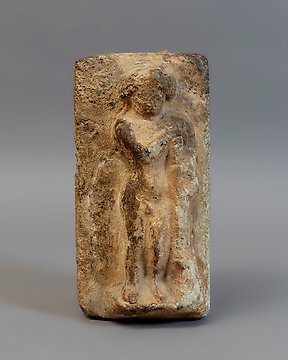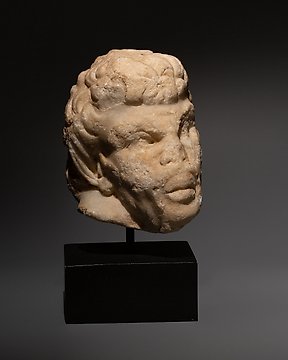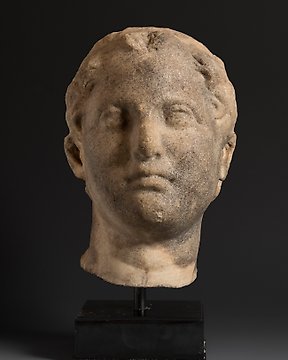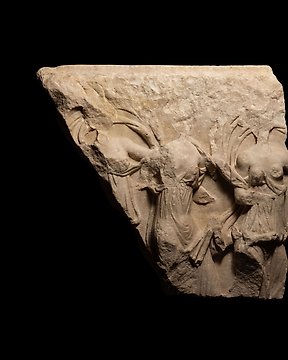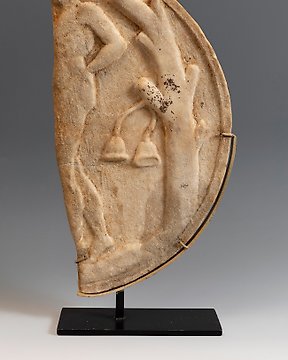Magnifique témoin du passé, envoyé avec tous les justificatifs, impeccable. Encore une fois très satisfait, un grand merci
Προβολή μετάφρασηςΑρχαία Ρωμαϊκή Μάρμαρο Κεφαλή Σατύρου. 1ος - 3ος αιώνας μ.Χ. 30 εκ. Υ. Ισπανική Άδεια Εξαγωγής.
Αρ. 84871065



Head of a Satyr
- refined style -
Roman Empire, 1st - 3rd century AD
MATERIAL: Marble.
DIMENSIONS: 30 cm height with stand, 17 cm height without stand.
PROVENANCE: Private collection, Berlin, Germany. Old collection before 2nd world war.
CONDITION: Good conditon, not restored.
DESCRIPTION:
Roman head made in marble representing a satyr, which can be deduced from the treatment of the hair, through the somewhat anarchic-looking curls (although, due to erosion, part of this disorderly representation of the locks has been lost) and, above all, the large mouth, insinuating a sardonic smile, which are common characteristics in the representation of this mythological character. The carver combines idealism and realism, a fact that was common in Roman statuary. The hair, the treatment of the eyes, and the strict symmetry bring us closer to this idealism that sought to represent harmony. However, the protruding lips and cheekbones show an almost animalistic expressiveness.
Related to the Maenads, the satyrs form the 'Dionysian retinue' that accompanies the god Dionysus. They are depicted in various forms; the most common (and basically Roman) is that of a half-man half-ram creature, with pointed ears and horns on the head, abundant hair, a flat nose, a goat's tail and a permanent priapism. One tradition considered the sons of Silenus, named Maron, Leneus and Astreo, to have been the fathers of the satyrs. All three were in the retinue of Dionysus when he travelled to India and, in fact, Astreo was the driver of his chariot. As we can see in this Roman sculpture, satyrs are cheerful and mischievous creatures, although their lighthearted and festive nature can turn dangerous and even violent (which explains why our sculpture has a frown on its face). As Dionysian creatures, they are lovers of wine and enjoy carnal pleasures.
Satyr and Silenus, in Greek mythology, creatures of the wild, part man and part beast, who in Classical times were closely associated with the god Dionysus. Their Italian counterparts were the Fauns (see Faunus). Satyrs and Sileni were at first represented as uncouth men, each with a horse’s tail and ears and an erect phallus. In the Hellenistic age they were represented as men having a goat’s legs and tail. The occurrence of two different names for the creatures has been explained by two rival theories: that Silenus was the Asian Greek and Satyr the mainland name for the same mythical being; or that the Sileni were part horse and the Satyrs part goat. Neither theory, however, fits all the examples in early art and literature. From the 5th century BC the name Silenus was applied to Dionysus’ foster father, which thus aided the gradual absorption of the Satyrs and Sileni into the Dionysiac cult. In the Great Dionysia festival at Athens three tragedies were followed by a Satyr play (e.g., Euripides’ Cyclops), in which the chorus was dressed to represent Satyrs. Silenus, although bibulous like the Satyrs in the Satyr plays, also appeared in legend as a dispenser of homely wisdom.
In art the Satyrs and Sileni were depicted in company with nymphs or Maenads whom they pursued. (Their amorous relations with nymphs are described as early as the Homeric Hymn to Aphrodite.) The Greek sculptor Praxiteles represented a new artistic type in which the Satyr was young and handsome, with only the smallest vestiges of animal parts. Hellenistic artists developed that concept into humorous or forceful representation of half-animal subjects as an escape from the merely human.
Notes:
The seller guarantees that he acquired this piece according to all national and international laws related to the ownership of cultural property. Provenance statement seen by Catawiki.
The seller will take care that any necessary permits, like an export license will be arranged, he will inform the buyer about the status of it if this takes more than a few days.
The piece includes authenticity certificate.
The piece includes Spanish Export License.
#historyroom
Ιστορία πωλητή
Head of a Satyr
- refined style -
Roman Empire, 1st - 3rd century AD
MATERIAL: Marble.
DIMENSIONS: 30 cm height with stand, 17 cm height without stand.
PROVENANCE: Private collection, Berlin, Germany. Old collection before 2nd world war.
CONDITION: Good conditon, not restored.
DESCRIPTION:
Roman head made in marble representing a satyr, which can be deduced from the treatment of the hair, through the somewhat anarchic-looking curls (although, due to erosion, part of this disorderly representation of the locks has been lost) and, above all, the large mouth, insinuating a sardonic smile, which are common characteristics in the representation of this mythological character. The carver combines idealism and realism, a fact that was common in Roman statuary. The hair, the treatment of the eyes, and the strict symmetry bring us closer to this idealism that sought to represent harmony. However, the protruding lips and cheekbones show an almost animalistic expressiveness.
Related to the Maenads, the satyrs form the 'Dionysian retinue' that accompanies the god Dionysus. They are depicted in various forms; the most common (and basically Roman) is that of a half-man half-ram creature, with pointed ears and horns on the head, abundant hair, a flat nose, a goat's tail and a permanent priapism. One tradition considered the sons of Silenus, named Maron, Leneus and Astreo, to have been the fathers of the satyrs. All three were in the retinue of Dionysus when he travelled to India and, in fact, Astreo was the driver of his chariot. As we can see in this Roman sculpture, satyrs are cheerful and mischievous creatures, although their lighthearted and festive nature can turn dangerous and even violent (which explains why our sculpture has a frown on its face). As Dionysian creatures, they are lovers of wine and enjoy carnal pleasures.
Satyr and Silenus, in Greek mythology, creatures of the wild, part man and part beast, who in Classical times were closely associated with the god Dionysus. Their Italian counterparts were the Fauns (see Faunus). Satyrs and Sileni were at first represented as uncouth men, each with a horse’s tail and ears and an erect phallus. In the Hellenistic age they were represented as men having a goat’s legs and tail. The occurrence of two different names for the creatures has been explained by two rival theories: that Silenus was the Asian Greek and Satyr the mainland name for the same mythical being; or that the Sileni were part horse and the Satyrs part goat. Neither theory, however, fits all the examples in early art and literature. From the 5th century BC the name Silenus was applied to Dionysus’ foster father, which thus aided the gradual absorption of the Satyrs and Sileni into the Dionysiac cult. In the Great Dionysia festival at Athens three tragedies were followed by a Satyr play (e.g., Euripides’ Cyclops), in which the chorus was dressed to represent Satyrs. Silenus, although bibulous like the Satyrs in the Satyr plays, also appeared in legend as a dispenser of homely wisdom.
In art the Satyrs and Sileni were depicted in company with nymphs or Maenads whom they pursued. (Their amorous relations with nymphs are described as early as the Homeric Hymn to Aphrodite.) The Greek sculptor Praxiteles represented a new artistic type in which the Satyr was young and handsome, with only the smallest vestiges of animal parts. Hellenistic artists developed that concept into humorous or forceful representation of half-animal subjects as an escape from the merely human.
Notes:
The seller guarantees that he acquired this piece according to all national and international laws related to the ownership of cultural property. Provenance statement seen by Catawiki.
The seller will take care that any necessary permits, like an export license will be arranged, he will inform the buyer about the status of it if this takes more than a few days.
The piece includes authenticity certificate.
The piece includes Spanish Export License.
#historyroom
Ιστορία πωλητή
- 747
- 6
- 0
Thank you for the Special offer and the fast shipping of this excellent piece of art!
Προβολή μετάφρασηςvery good description of the object, very good price for this rare item,. Fast sending (has been at my place 2 days after buying!). Definitely would buy again.
Προβολή μετάφρασηςSehr schön
Προβολή μετάφρασηςAs described, perfect logistic
Προβολή μετάφρασηςgreat seller, everything came as should with certificate of authenticity
Προβολή μετάφρασηςExceptionally well packaged, description aligned with positing received
Προβολή μετάφρασηςReally precious, but without sound...
Προβολή μετάφρασηςPainting well packed and rapidly sent!
Προβολή μετάφρασηςsempre grande rapidità e professionalità
Προβολή μετάφρασηςparfait bien reçu, merci
Προβολή μετάφρασηςVery satisfied with the small Greek Lekythos. As always (we have already bought several items from Bagot), the object was wrapped and sent immediately and with the greatest care.
Προβολή μετάφρασηςPerfect, excellent condition, good packaging, the parcel arrived without any problems… all is perfect as usual. Thank you very much and wait for an other nice piece like this one. Gilles.
Προβολή μετάφρασης+++ Top vendeur professionnel comme d'habitude
Προβολή μετάφρασηςEmbora o custo de transporte esteja acima da média foi, realmente, muito bem executado e em embalagem cuidada. Expeditos e profissionais. Recomendo
Προβολή μετάφρασηςSnel en correct en goed verpakt verzonden
Προβολή μετάφρασηςoggetto bellissimo, fedele alla descrizione, venditore affidabile
Προβολή μετάφρασηςVery nice piece and fast delivery
Προβολή μετάφρασηςEverything ok, top seller! Thank you again!
Προβολή μετάφρασηςvery beautiful and fast shipping!thank you!
Προβολή μετάφρασηςExcelent, very good piece++++
Προβολή μετάφρασηςVendedor increíble muy buenos he comprado muchas veces todo perfecto. Muchas gracias
Προβολή μετάφρασηςpas de problème ; merci beaucoup
Προβολή μετάφρασηςtres rapide conforme hope next +++
Προβολή μετάφρασηςSehr schön! Vielen Dank!
Προβολή μετάφρασης- 747
- 6
- 0
Magnifique témoin du passé, envoyé avec tous les justificatifs, impeccable. Encore une fois très satisfait, un grand merci
Προβολή μετάφρασηςΑποποίηση ευθυνών
Ο πωλητής εγγυάται και μπορεί να αποδείξει ότι το αντικείμενο αποκτήθηκε νόμιμα. Ο πωλητής ενημερώθηκε από την Catawiki ότι έπρεπε να παράσχει τα δικαιολογητικά που απαιτούνται από τους νόμους και τους κανονισμούς στη χώρα διαμονής τους. Ο πωλητής εγγυάται και δικαιούται να πουλήσει/εξάγει αυτό το αντικείμενο. Ο πωλητής θα παρέχει στον αγοραστή όλες τις πληροφορίες προέλευσης που είναι γνωστές για το αντικείμενο. Ο πωλητής διασφαλίζει ότι οποιεσδήποτε απαραίτητες άδειες έχουν ήδη κανονιστεί /θα κανονιστεί. Ο πωλητής θα ενημερώσει αμέσως τον αγοραστή για τυχόν καθυστερήσεις στην απόκτηση τέτοιων αδειών.
Ο πωλητής εγγυάται και μπορεί να αποδείξει ότι το αντικείμενο αποκτήθηκε νόμιμα. Ο πωλητής ενημερώθηκε από την Catawiki ότι έπρεπε να παράσχει τα δικαιολογητικά που απαιτούνται από τους νόμους και τους κανονισμούς στη χώρα διαμονής τους. Ο πωλητής εγγυάται και δικαιούται να πουλήσει/εξάγει αυτό το αντικείμενο. Ο πωλητής θα παρέχει στον αγοραστή όλες τις πληροφορίες προέλευσης που είναι γνωστές για το αντικείμενο. Ο πωλητής διασφαλίζει ότι οποιεσδήποτε απαραίτητες άδειες έχουν ήδη κανονιστεί /θα κανονιστεί. Ο πωλητής θα ενημερώσει αμέσως τον αγοραστή για τυχόν καθυστερήσεις στην απόκτηση τέτοιων αδειών.



